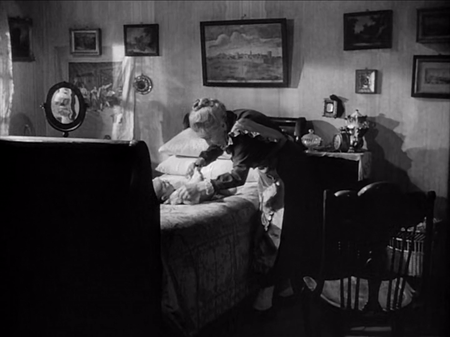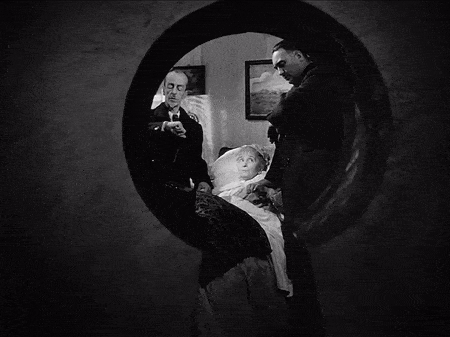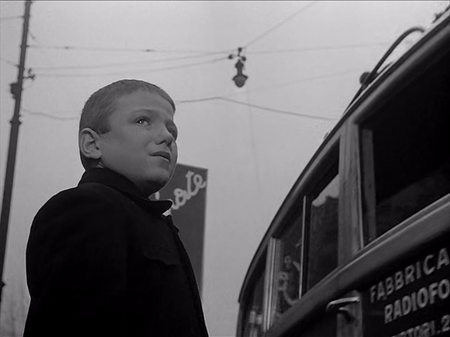Regia / Director: Vittorio De Sica, 1951
Sceneggiatura / Screenplay: Cesare Zavattini
Soggetto / Story: Cesare Zavattini (Totò il Buono, 1943)
Fotografia / Cinematography: Aldo Graziati
Progetto di produzione / Production design: Guido Fiorini
Effetti speciali / Special effects: Ned Mann
“C'era una volta…” Lolotta (Emma Gramatica) esce dalla sua casetta con in mano un annaffiatoio gigante. Con i suoi muri bianchi e il tetto di tegole, la casetta sembra essere in una fiaba. Ma notiamo alcune ciminiere di fabbriche sullo sfondo.
“Once upon a time…” Lolotta walks out of her cottage holding a giant watering can. With its white walls and tiled roof, the cottage looks as if it is in a fairy tale. But we notice factory smokestacks in the background.
Avvolta nel suo scialle all'uncinetto, cammina lungo il fiume fino al suo giardino e comincia a innaffiare.
In her crocheted shawl, she walks by the river to her garden, and begins watering.
Nel campo di cavoli, si ferma per un momento a fischiare a un uccello su un albero. Lei sembra parte integrante del suo piccolo paesaggio cittadino: il giardino e gli edifici sullo sfondo.
In the cabbage patch, she stops for a moment to whistle to a bird up in a tree. She seems an integral part of her little town landscape: the garden and the buildings in the background.
Si sente un pianto e Lolotta si gira e rigira, cercando di localizzare da dove viene. Poi vede! Getta l'annaffiatoio da parte...
We hear crying, and Lolotta turns around and around, trying to locate where it’s coming from. Then she sees! She tosses the watering can aside…
...e si precipita verso il suono.
…and rushes towards the sound.
Chinandosi, vede un bambino, piccolo e nudo, mezzo nascosto dai cavoli.
Bending down, she sees a baby, small and naked, half hidden by the cabbages.
Lolotta si toglie lo scialle e lo avvolge intorno al bambino, prendendolo in braccio.
Lolotta takes off her shawl and wraps it around the infant, picking him up in her arms.
Mentre il bambino piagnucola, Lolotta lo porta attraverso il campo di cavoli fino alla sua casetta.
While the baby whimpers, Lolotta carries him through the cabbage patch back to her cottage.
Dentro, il bambino sta ancora piangendo, ma Lolotta ride di gioia. Un neonato!
Inside, the boy is still crying, but Lolotta laughs with delight. A baby!
Lo stende sul letto, stringendosi le mani per l'emozione. Ritratti incorniciati affollano il muro della sua camera da letto.
She lays him out on the bed, clasping her hands together in emotion. Framed pictures crowd her bedroom wall.
Parla felicemente con il bambino, che sembra essere un dono del cielo.
She talks happily to the child, who seems to be a gift from heaven.
La cosa successiva che vediamo è il latte che schiuma sul fornello, mentre Totò (Gianni Branduani), ora undicenne, sta a guardare affascinato.
The next thing we see is milk foaming on the stove, as Totò, now eleven years old, stands watching in fascination.
Mamma Lolotta arriva a casa!
Mama Lolotta arrives home!
Vestita di pizzo nero, lei gli dice: "Buongiorno!" e guardano insieme il latte.
Dressed in black lace, she bids him, “Good morning!” and they gaze at the milk together.
La schiuma si versa sul pavimento!
The foam pours onto the floor!
Non importa! Lolotta sorride, dando semplicemente una pacca sulla spalla del figlio. Si solleva la lunga gonna, si avvicina alla stufa e si inginocchia per tirare fuori qualcosa da sotto. Una scatola.
No matter! Lolotta smiles, simply patting her son’s shoulder. She lifts her long skirt, steps over to the stove, and kneels down to pull something out from underneath. A box.
Lei la porta a Totò, che, con un bavaglino al collo, è incorniciato da una porta aperta e da un elegante disegno di linee oblique. Lolotta gli mostra qualcosa dalla scatola: una piccola casa.
She carries it to Totò, who, with a bib around his neck, is framed by an open doorway and an elegant pattern of slanting lines. Lolotta shows him something from the box: a tiny house.
Uno ad uno, dispone sul pavimento altri pezzi in miniatura: case e alberi. Poi, giocosamente, salta in mezzo alla piccola città che ha fatto, mentre lui la guarda meravigliato.
One by one, she sets out other miniature pieces on the floor: houses and trees. Then playfully she jumps into the middle of the little town she’s made, as he looks on in wonder.
"Com’è grande la Terra!" esclama lei, tenendo le braccia aperte. Si tengono per mano e ridono, saltellando nella loro città.
“How big the Earth is!” she exclaims, holding her arms wide open. They hold hands and laugh, hopping in their town.
Nel giardino non fiorisce nulla; un vaso rotto giace su un lato. Mentre Totò guarda fuori dalla finestra, vediamo Lolotta, nello specchio, che lo guarda.
In the garden, nothing is blooming; a broken pot lays on its side. As Totò looks out of the window, we see Lolotta, in the mirror, watching him.
In camicia e cuffia da notte di pizzo bianco, Lolotta prende le mani del ragazzo. Sentiamo il ticchettio dell'orologio.
Lei gli chiede: "Quanto fa sette per sette?"
"Quarantanove", risponde lui dolcemente.
In her nightgown and white lacy cap, Lolotta takes the boy’s hands. We hear the ticking of the clock.
She asks him, “How much is seven times seven?”
“Forty-nine,” he answers softly.
Alla finestra, due uomini in abito e fedora sbirciano.
"E sei per sei?"
Una lacrima gli arriva all'occhio. "Trentasei".
At the window, two men in suits and fedoras peek in.
“And six times six?”
A tear comes to his eye. “Thirty-six.”
"Tre per tre?"
Il bambino è sopraffatto dall'emozione e le lacrime gli riempiono gli occhi. Bussano alla porta. "Quindici".
“Three times three?”
The little boy is overwhelmed by emotion and tears well up in his eyes. There’s a knock at the door. “Fifteen.”
In silenzio, gli uomini fanno segno a Totò di andarsene.
Silently, the men gesture to Totò to leave.
Lui chiude la porta e guarda attraverso il buco della serratura.
He closes the door and looks through the keyhole.
Oh, questi uomini solenni sono medici!
Oh! These solemn men are doctors!
La macchina da presa zooma attraverso il buco della serratura e si ferma sul viso di Lolotta. Lei guarda con diffidenza prima l’uno e poi l’altro medico. Ognuno le tiene un polso e – guardando prima l’orologio, poi il soffitto e poi chiudendo gli occhi per la concentrazione – mormora: "Sessantadue... sessantatre... sessantaquattro..."
The camera zooms in through the keyhole and stops on Lolotta’s face. She looks warily first at one man then at the other. Each holds one of her wrists and – first looking down at his watch, then up at the ceiling, then closing his eyes in concentration – murmurs: “Sixty-two… sixty-three… sixty-four...”
Totò cammina dietro la carrozza e il cavallo che porteranno il corpo di Lolotta al cimitero; la mano del guidatore si posa sulla sua spalla. Il mondo è grigio, e l'oscurità sembra raccogliersi intorno al carro funebre. Al centro dell'inquadratura, intravediamo la croce in cima al carro.
Totò walks behind the coach and horse that will carry Lolotta’s body to the cemetery; the driver’s hand rests on his shoulder. The world is gray, and darkness seems to gather around the hearse. At the center of the frame, we just barely see the cross on top of the coach.
Tutto solo, il ragazzo cammina per le strade bagnate dietro la carrozza. I passanti, a piedi o in bicicletta, si tolgono il cappello in segno di rispetto.
All alone, the boy walks through the wet streets behind the carriage. Passers-by, on foot or on bicycles, tip their hats in respect.
Nel centro della città passa un tram. Il ragazzo è vestito di nero, con i calzini bianchi che spuntano dagli stivali. Porta il suo berretto in una mano, gli occhi bassi.
In the center of the city, a tram goes by. The boy is dressed in black, with white socks poking out from his boots. He carries his cap in one hand, eyes downcast.
Una colonna di uomini sfila accanto a lui. Ognuno porta un cartello identico che pubblicizza la ditta di scarpe Faita: "Camminate felice", dice. Totò sta in piedi in primo piano, inconsolabile, mentre i cartelli lo sovrastano, uno per uno.
A column of men parades by him. Each carries an identical sign advertising the Faita shoe company: “Walk happy,” it says. Totò stands in the foreground, inconsolable, as the signs overwhelm him, one by one.
Fermandosi, il cocchiere gli urla: "Bambino, andiamo?" Totò corre a raggiungerlo.
Stopping, the coach driver calls to him, “Little boy, shall we go?” Totò runs to catch up.
Continua a camminare nella foschia dietro il carro funebre, accanto a una fila di alberi spogli e sottili.
He walks on through the haze behind the hearse, beside a line of bare and spindly trees.
La foschia è sparita: Totò cammina, berretto in testa, portando una borsa con i suoi averi. Cammina tra due uomini con cappotti e cappelli invernali. Indossano abiti grigi come i medici di Lolotta.
The haze is gone: Totò walks, cap on head, carrying a bag with his belongings. He walks between two men in winter coats and hats. They wear gray suits like Lolotta’s doctors.
Attraversano la strada verso un vecchio edificio in pietra: l'orfanotrofio che è la nuova casa di Totò. Li vediamo passare sotto l'alto arco, attraversando la soglia. Cosa sarà di Totò senza la sua amata Lolotta?
They cross the street toward an old stone building: the orphanage that is Totò’s new home. We see them pass under the tall archway, crossing the threshold. What will become of Totò without his beloved Lolotta?
FINE PARTE 1
Here is Parte 2 of this cineracconto. Subscribe to receive a weekly email newsletter with links to all our new posts.
A note about the translation:
The dialogue in the cineracconto (photo-story) of MIRACOLO A MILANO (Miracle in Milan), for the most part, reflects the actual spoken dialogue of the film. Occasionally, we’ve changed a word or phrase to a more basic level to make the cineracconto more accessible to a wider range of language learners. But for the most part, you’ll see the actual battute (spoken lines).
We have translated the Milanese dialect spoken by many of the characters into standard Italian. For example, in Parte III, a character says, “Le’ minga possibile andare avanti insci’,” which we have changed to "Non è possibile andare avanti così!"
While our past, more advanced level cineracconti (up to THE SOUTHERNER, June 2021) included pretty much every scene and nearly all the dialogue verbatim from our films, our lower intermediate level cineracconti (starting with OSSESSIONE, September 2021) are shorter and recount a more abbreviated version of the film. (To see the more advanced cineracconti, please go to the blog Welcome page where the Italian movies are listed on top; Italian and international films are directly below, in chronological order.)
In writing our cineracconti, we aim for a fluid, standard Italian – though in places, it might seem more basic than how an average Italian would speak. Then we write an English translation – which is naturally also at an intermediate level of English. You will not see a literal – word-for-word – translation, but rather, a “literary” one: an accurate representation of how someone would actually say the line in standard American English.
We love language and we sometimes spend a very long time debating a particular word or phrase. We’d be very happy to hear your thoughts about our translations. Write to us at info@liconoscevobene.net!







































































